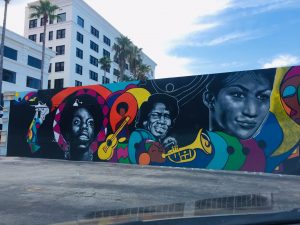
By Sandra Schulman
Miles Davis, Nina Simone, James Brown, Marvin Gaye, Aretha Franklin, and Billie Holiday — several of these iconic artists performed in West Palm Beach’s Historic Northwest neighborhood, usually at the Sunset Lounge, which is now under restoration.
Now the West Palm Beach Downtown Development Authority (DDA) and West Palm Beach Arts & Entertainment District are partnering with Subculture Group and the artists of Street Art Revolution to create a powerful new mural on the long wall at Camelot on South Narcissus Avenue in downtown West Palm Beach.
Titled The Revolution of the Groove, the 100-feet-wide by 80-feet-tall mural depicts six revolutionary African-American artists who utilized their lives and their music during their eras of social injustice and racism. Work began the week of July 12 and completion is expected by this Sunday.
Headed up by Street Art Revolution artists Anthony Hernandez and Caron Bowman, this Black-owned artist-led public art collective and firm, is one of the few of its kind in the country that specializes in highly curated public art, civic design, and sculptures. A companion mural of civil rights icons is up now at Clematis Street.
“This project has been a labor love for Street Art Revolution,” says Bowman in an email. “In 2017, Anthony Hernandez and I started talking about doing a mural on Miles Davis, who had performed at the Sunset Lounge. We decided to expand the scope of the project and approach the Subculture Group and the West Palm Beach Downtown Development Authority and the Arts and Entertainment District with the idea. They loved it and graciously agreed to work with us on the project.”
The musicians were chosen according to their cultural impact, Bowman says.
“The mural is called ‘The Revolution of the Groove,’” she adds. “As part of the curatorial framework for the project, we selected artists whose music had a great social impact on the civil rights movement. We oftentimes do not think of it but the first line of the civil rights movement in the African-American community was through our music. It often expressed the pain and suffering of our people, the injustice, and hope for a better future.”
The mural is designed with the figures in black-and-white, then vibrant, wild color as a background that contains historical references.
“We felt this was the best way to merge our contrasting styles,” Bowman explains. “We felt the black-and-white gave balance to the multi-colored background. Mr. Hernandez’s work explores realism and the beauty of portraiture, on the other hand, my work explores vibrant colors abstraction, and symbolism. Since one of my degrees is in history, I like to incorporate historical iconography into my artwork.
“The abstraction in the mural was influenced by African-American Underground Railroad quilts which were encoded with symbols that represented a roadmap to freedom for runaway slaves. For example, the crown around Nina Simone’s head has the crossroad pattern and the hourglass pattern. I feel that the uniqueness of each one of our styles has produced a cutting-edge piece of artwork that is diverse in imagery and powerful in its cultural impact.”
Younger viewers may not know who the figures are, so it’s also a learning experience.
“The power of music and its ability to communicate was a vital part of the civil rights movement,” says Bowman. “Blues music tells the story of life’s difficulties and takes the hardest realities of black life and puts them into music, only to come out with some new hope or sense of triumph. The work of these artists was just as powerful as any civil rights protest.
“African-American music is one of the most unique art forms to develop out of American society. I would hope that people would not simply look at this as just black culture but celebrate it as part of American culture. The music of these artists went way beyond the confines of the African-American community to express to the world the fight for freedom, justice, and equality,” she said.
City officials applaud the effort.
“These new murals not only bring new vibrancy to Downtown West Palm Beach but also honor the history and legacy that influence our future,” said Teneka James-Feaman, associate executive director of the DDA, in a prepared statement. “We’re proud to partner with Subculture and Street Art Revolution to further enhance the downtown experience.”
For more information on Street Art Revolution, please visit their website at streetartrevolution.org.